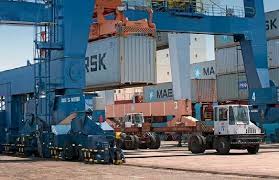New Dawn for Kenya’s Blue Economy: Safeguarding Lives and Livelihoods

Blue economy protecting livelihoods in shared oceans. (Photo/Courtesy)
By Andrew Mwangura
Email, thecoastnewspaper@gmail.com
On August 15, 2025, Malindi became the stage for a transformative moment in Kenya’s Blue Economy, as Cabinet Secretary for Mining, Blue Economy, and Maritime Affairs, Hon. Hassan Ali Joho, launched a state-of-the-art sea rescue boat and inspected the construction of a modern fish market in Malindi town.
These initiatives, spearheaded by the Kenya Maritime Authority (KMA) in collaboration with the Fisheries Department, represent a bold step toward enhancing maritime safety and fostering economic growth along Kenya’s coastline and inland waters. Accompanied by Kilifi Governor H.E. Gideon Mung’aro, MPs Hon. Amina Mnyazi (Malindi) and Hon. Paul Katana (Kaloleni), Principal Secretaries Ms. Betsy Njagi (Blue Economy and Fisheries) and Mr. Fikirini Jacobs (Youth Affairs and Creative Economy), and other national and county leaders, Joho’s visit underscored a unified commitment to protecting lives and unlocking the economic potential of Kenya’s marine resources.
The launch of the rescue boat and the fish market project signals a brighter, safer, and more prosperous future for coastal and lakeside communities.
The introduction of the sea rescue boat, procured through the KMA and managed alongside three patrol boats from the Fisheries Department, is a critical response to the alarming rate of marine casualties in Kenya’s territorial waters and inland lakes.
Kenya’s 650-kilometer coastline along the Indian Ocean and its vast inland water bodies, including Lake Victoria, Lake Turkana, Lake Jipe, and Lake Chala, are economic lifelines but also perilous environments.
According to the Lake Victoria Basin Commission (LVBC), approximately 5,000 people lose their lives annually in drowning incidents on Lake Victoria alone, attributed to overloading, unstable boats, poor seamanship, bad weather, and lack of safety equipment.
A 2024 study on the Kenyan side of Lake Victoria found that 42% of 141 recorded fisher drownings were linked to extreme weather, with 69% of victims not wearing life jackets, despite Kenyan laws mandating their use. Night fishing, driven by the depletion of daytime catches like Nile perch, exacerbates risks due to rougher waters and limited visibility.
In Kenya’s territorial waters, data is less comprehensive, but the KMA has reported rising incidents of vessel capsizing and piracy threats, particularly in areas like Lamu, where unregulated fishing and smuggling are prevalent.
Lake Turkana, Kenya’s largest lake by area (6,405 km²), sees fewer reported casualties but faces challenges from strong winds and inadequate rescue infrastructure, with local fishers often using makeshift boats.
Smaller lakes like Jipe (39 km²) and Chala, which straddle the Kenya-Tanzania border, lack systematic casualty data but are known for occasional accidents due to shallow waters and limited navigation aids.
The new rescue boat, equipped with advanced navigation and communication systems, will bolster rapid response capabilities across these waters, addressing a critical gap in Kenya’s maritime safety framework.

The importance of rescue boats cannot be overstated in a country where marine and inland water activities sustain millions of livelihoods.
The Indian Ocean and Kenya’s lakes are vital for fishing, transport, and tourism, yet they pose significant risks. Storms, unpredictable currents, and the absence of coordinated rescue services have led to preventable tragedies.
For instance, a 2012 incident in Lake Victoria saw six young men drown after their boat capsized due to a leak and lack of safety equipment, a stark reminder of the human cost of inadequate infrastructure. The new rescue boat, insured and maintained by the KMA, will operate alongside vessels from the EU-funded Go Blue project, which delivered five boats in October 2024 to counties from Kwale to Lamu.
These vessels create a network of rapid-response units, capable of addressing distress calls in real time.
Beyond saving lives, the boat enhances ocean surveillance, combating illegal, unreported, and unregulated (IUU) fishing, which costs Kenya billions annually.
By strengthening monitoring in the Exclusive Economic Zone (EEZ), the KMA ensures the protection of marine resources, securing the economic future of coastal communities.
Parallel to the safety focus, the Malindi fish market project promises to revolutionize the local economy. Coastal fishers have long faced exploitation by middlemen and limited market access, forcing them to sell at low prices.
The modern facility, part of broader initiatives like the Kenya Marine Fisheries and Socio-Economic Development (KEMFSED) project, will enable value addition through processing and storage, ensuring better prices and job creation. This aligns with Joho’s vision of a vibrant Blue Economy, encompassing fisheries, aquaculture, and tourism.
The market will position Malindi as a hub for marine products, attracting investment and empowering youth and women in Kilifi and beyond.
The collaborative presence of leaders like Governor Mung’aro and MPs Mnyazi and Katana during the inspection highlights the synergy between national and county governments in driving this agenda.
These initiatives reflect a broader strategy to harness Kenya’s Blue Economy while addressing its challenges.
Since taking office in August 2024, Joho has championed projects like the National Marine Hatchery in Shimoni and the Liwatoni Fisheries Complex, emphasizing sustainable development and public-private partnerships. However, sustaining these gains requires ongoing investment and community engagement to ensure benefits reach small-scale fishers.
The high casualty rates in Lake Victoria and other waters underscore the urgency of expanding rescue operations and enforcing safety regulations, such as mandatory life jacket use.
By addressing these issues, Kenya can transform its maritime sector into a global model of safety and prosperity.
In conclusion, the launch of the sea rescue boat and the Malindi fish market on August 15, 2025, marks a pivotal moment for Kenya’s Blue Economy.

The rescue boat addresses the dire need for safety in waters where thousands perish annually, while the fish market empowers coastal communities economically. Together, they embody a vision of a safer, more prosperous Kenya, driven by sustainable maritime development.
With continued leadership from figures like Joho and collaboration across government levels, Kenya is poised to lead in maritime excellence, ensuring its oceans and lakes thrive for generations.
The author is a policy analyst specializing in maritime governance and blue economy development.






